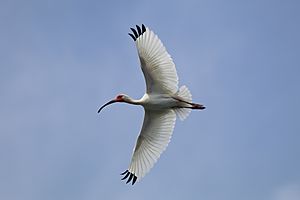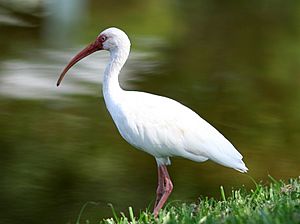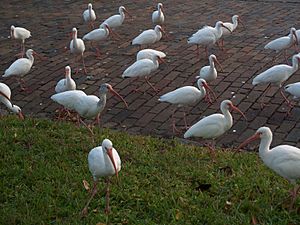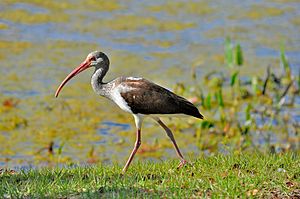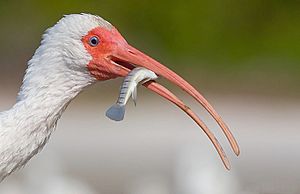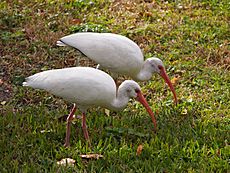American white ibis facts for kids
Quick facts for kids American white ibis |
|
|---|---|
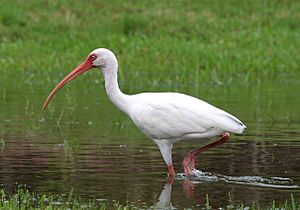 |
|
| An American white ibis wading in the Tampa Bay area of Florida | |
| Conservation status | |
| Scientific classification | |
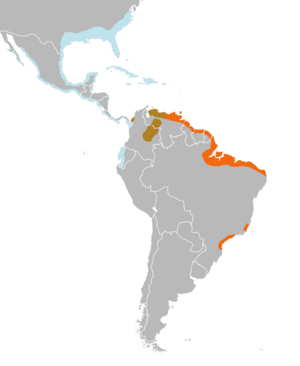 |
|
| Range of American white ibis (E. albus) Range of scarlet ibis (E. ruber) Overlapping range of both species | |
| Synonyms | |
|
The American white ibis (Eudocimus albus) is a type of bird from the ibis family. You can find it from Virginia all the way down the Gulf Coast of the United States and through most of the warm coastal areas of the New World.
This ibis is a medium-sized bird. It has white feathers, a bright red-orange bill that curves downwards, and long legs. Its black wing tips are usually only seen when it flies. Male ibises are bigger and have longer bills than females.
These birds mostly eat small water animals like insects and tiny fish. Crayfish are their favorite food in many places. They can change what they eat depending on where they live and how much food is available. They mostly find food by poking their beak into shallow water to feel for prey. They don't usually see their food.
During the time they have babies, American white ibises gather in huge groups called colonies near water. Most pairs stay together, and both parents take care of the young.
Pollution from humans has affected these birds. Chemicals like methylmercury can get into the environment from waste. When ibises are exposed to methylmercury, it changes their body chemistry. This affects how they mate and build nests, leading to fewer baby ibises.
Contents
About the American White Ibis
The American white ibis was first described by a famous scientist named Carl Linnaeus in 1758. He gave it the scientific name Scolopax albus. The word albus means "white" in Latin. Some people used to call it the Spanish curlew or white curlew.
Later, in 1832, another scientist named Johann Georg Wagler gave the bird its current scientific name, Eudocimus albus. This genus also includes the scarlet ibis (E. ruber).
Scientists have long debated if the white ibis and scarlet ibis are different species or just different types of the same species. They are very similar and live in overlapping areas. In some places, like Colombia and Venezuela, the two types of ibises have been seen mating and having babies together. These baby ibises often have pale orange feathers. This suggests they might be considered one species.
What They Look Like
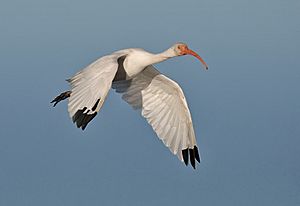
Adult American white ibises are easy to spot with their white feathers and pink skin on their faces. Their black wingtips are usually only seen when they fly. When they are not breeding, their long, curved bill and legs are bright red-orange.
During the breeding season, their skin gets darker. The bill becomes a deep pink, and the legs turn an almost purple-red. After a while, these colors fade to a paler pink, and the tip of the bill becomes blackish.
It's hard to tell male and female ibises apart just by looking at their feathers. However, males are usually bigger and heavier than females. They also have longer and thicker bills. Males can weigh about 870 to 1260 grams (about 2 to 2.8 pounds). Females weigh about 590 to 860 grams (about 1.3 to 1.9 pounds). These birds are about 53 to 70 cm (21 to 28 inches) long, with a wingspan of 90 to 105 cm (35 to 41 inches).
When baby ibises first hatch, they are covered in violet-colored down feathers. Their head and wings are dark brown or black. Their eyes are brown. Their skin is pink at first but turns gray within a few days.
Like other ibises, the American white ibis flies with its neck and legs stretched out. They often fly in long lines or V-shapes. This helps them save energy while flying.
The main sound an American white ibis makes is a honking noise, like "urnk, urnk" or "hunk, hunk." They use this call when flying, trying to find a mate, or when they are bothered. Young birds in the nest make a high-pitched "zziu" sound when they want food.
Similar Birds
It can be very hard to tell young American white ibises apart from young scarlet ibises. Scarlet ibises usually have darker legs and bare skin around their face. A young American white ibis might also look like a young glossy ibis. However, the glossy ibis is completely dark brown and doesn't have a white belly or rump. Adult white ibises are different from the wood stork, which is much larger and has more black on its wings.
Where They Live
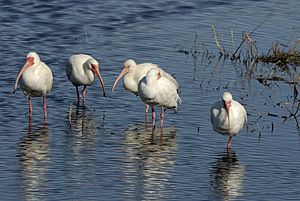
The American white ibis is most common in Florida. More than 30,000 have been counted in just one breeding colony there. They also live throughout the Caribbean, along both coasts of Mexico, and in Central America. You can find them as far south as Colombia and Venezuela.
When they are not breeding, their range extends further inland. They can be found north to Virginia and west to eastern Texas. Sometimes, these birds wander far from their usual areas and are seen in other states.
In North America, they breed along the Atlantic coast, from the Carolinas south to Florida. They also breed west along the Gulf Coast. They don't always return to the same breeding spots. Large groups of ten thousand birds or more can gather and then leave in just one or two breeding seasons.
The American white ibis lives in many different places. They prefer shallow coastal marshes, wetlands, and mangrove swamps. You can also find them in muddy pools, on mudflats, and even on wet lawns. Populations away from the coast, especially in southern Florida, often live in marshes, ponds, and flooded fields. In summer, they move to coastal areas when inland waters become too deep for them to find food.
How They Behave
A study in Florida showed that adult American white ibises spend about 10 hours a day looking for food. They spend less than an hour flying. The rest of their time, about 13 hours, is spent resting, sleeping, and taking care of their nests.
Much of their resting time is spent preening. This means they bite and work their feathers with their long bills. They also rub oil from special glands onto their back feathers. Ibises usually preen themselves. They only preen other birds when they are trying to find a mate. They often bathe before preening. They squat in shallow water and flick water over themselves with their wings. Many birds might bathe together when it's time to find a mate.
The American white ibis protects its nesting and display areas from other birds. If another bird comes too close, they might lunge forward with their bill or stand tall and snap their bill. They also lunge and bite, sometimes holding onto another bird's head or wings.
Reproduction and Life Cycle
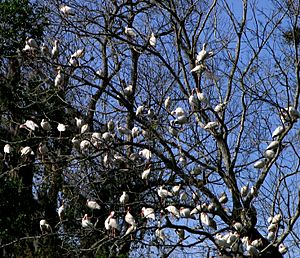
American white ibises find partners in spring and breed in huge colonies. They often share these colonies with other water birds. Nesting starts when there are good places to find food and build nests. The female chooses the spot, usually in a tree or bush over water, and builds the nest. Males help by bringing materials for the nest.
They usually lay one to five eggs, but two or three eggs are most common. The eggs are pale blue-green with brown spots. They are about 5.8 cm (2.3 inches) long and weigh about 50.8 grams (1.8 ounces).
During mating and when the eggs are being warmed, the male stays close to the nest. He defends his nest and mate from predators and other ibises. He will do this even if it means he doesn't eat much.

The success of ibis breeding depends on the water levels and rainfall. Low water levels mean it's easier to find prey. If water levels rise during the breeding season, it scatters the prey and makes it harder for them to find food. Fewer nests and smaller egg numbers happen when there isn't enough food.
The success rate of parents raising young to 20 days old can vary a lot, from 5% to 70% of nests. American white ibis parents have been known to feed their chicks things like cockroaches and rotting food from human trash in bad years. This happens when fish and crayfish are hard to find.
The main reason nests fail is that parents abandon them. This often happens because of very high tides that flood the nests. The eggs float out of the flooded nests or get washed away. Parents usually leave the nest if the water level reaches 3 to 8 cm (1 to 3 inches) above the bottom of the nest. However, sometimes parents have been seen moving their eggs to another nest to save them.
The eggs hatch after about three weeks. Both parents take care of the young. Males are at the nest most of the day, and females most of the night. They switch duties in the morning and evening. Most feeding of the chicks happens when the parents switch places.
Many young birds die in the first 20 days after hatching. In the Everglades, only 37% to 83% of hatchlings survive to three weeks old. When food is scarce, male baby ibises have a better chance of survival than females, even though males are larger. Scientists think parents might feed the larger males first, or the males might just be better at competing for food.
Birds like the fish crow often raid American white ibis nests. They can cause up to 44% of egg loss. Other animals that eat eggs and young include boat-tailed grackles, black-crowned night herons, gulls, and possibly vultures. Mammals like the common opossum, raccoon, and rat snakes also prey on them.
American white ibises start breeding in their third summer. In captivity, they can breed as young as nine or ten months old. The oldest ibis in captivity lived for over 20 years. A wild bird was found 16 years and 4 months after it was tagged.
What They Eat
The American white ibis loves to eat crayfish and other crustaceans. They also eat aquatic insects and small fish. When it's not nesting season, their diet changes a lot depending on the area and habitat. In places like the Llanos in Colombia and Venezuela, they mostly eat insects like fly larvae and beetles. In North America, their main food is crustaceans, especially crayfish.
In the Everglades, they mostly eat crayfish. Ibises in mangrove swamps focus on crabs. Because they find food by feeling with their bill in the mud, they catch prey that are too slow to get away. If there are many fish, they might switch to eating fish instead of crayfish. Fish give them more energy.
American white ibises sometimes feed in groups with other birds like the glossy ibis. They often eat different things, so they don't compete for food. For example, the glossy ibis might eat grain, while the white ibis looks for crabs and water insects.
Sometimes, other birds like the willet follow American white ibises and catch prey that the ibises disturb. They might even steal food from them! In one rare case, a young American white ibis was seen attacking and eating a chick from another nest.
How They Find Food
During the summer, American white ibises search for food along coastal mudflats and mangrove swamps. This is because inland marshes are usually flooded. But as water levels drop in the fall, they move inland to marshes and swamps. Since the late 1990s, they have become more common in Florida cities. They often look for food in man-made ponds on golf courses.
The American white ibis finds food by touch, not by sight. This means they can't choose from many different types of prey. They slowly walk through shallow water and stick their long, curved bill into the mud. They sweep their bill back and forth to find food. They might also poke their bill into the mud while standing still.
Sometimes, if they are alone in deeper water, they will open their bill wide and swing it from side to side. Other ibises might copy this behavior if they see it. On land, the American white ibis finds prey by seeing it and pecking at it. They don't need to put their bill into the ground.
American white ibises look for small prey when other birds are around. This is because it takes them time to break up larger food items. Other predators like herons and egrets often try to steal their catch.
During the breeding season, adult male ibises have been seen stealing food from other parent ibises who are feeding their young. The male raiders force their bill down the throat of the victim bird to get the food. This helps the male ibises get food without having to leave the nest for long periods. Females and young birds almost never try to fight off the larger, more aggressive males.
Threats and Conservation
Scientists don't know much about what causes adult ibises to die. Alligators might eat nesting ibises, but there hasn't been much research on this.
Many types of parasitic worms have been found in American white ibises. These worms mostly live in their stomachs and intestines. Some worms are more common in ibises from freshwater habitats, while others are found more in saltwater areas.
The American white ibis is listed as a species of "Least Concern" by the IUCN Red List. This means their population is not currently in danger. There are about 150,000 adult birds, and their numbers are stable. However, some populations have changing numbers.
It's hard to count the exact number of breeding birds because they move around a lot. In 2001, about 166,000 breeding birds were counted in Texas, Louisiana, Florida, and the Carolinas. In 2004, that number was 209,000.
Protecting the places where they nest and find food is important to keep their populations healthy. But because their breeding colonies move around so much, this can be a challenge.
Human Impact
Historically, people used to hunt American white ibises and sell them for food. Native Americans also ate them. Their meat was said to taste like fish. Hunting has caused their numbers to go down in some areas. Crawfish farmers in Louisiana have also shot them for eating crawfish from their ponds. However, hunting is not thought to be a major threat today.
The pollutant methylmercury is a chemical that can harm the brain and body. In the Everglades, human pollution has caused more methylmercury to be in the environment. This has affected the behavior of the American white ibis. It changes the hormone levels in male ibises. This makes them less likely to do important courtship behaviors, and females approach them less during mating season. This has led to fewer baby ibises being born.
Exposure to methylmercury also makes it harder for ibises to find food. It also makes them more likely to abandon their nests. This is because the pollutant affects their hormones, which impacts how they care for their young.
In Culture
In Native American stories, people believed the ibis was the last bird to find shelter before a hurricane. It was also the first bird to come out afterwards. Because of this, the bird became a symbol of both danger and hope.
For this reason, the University of Miami chose the American white ibis as its official sports mascot in 1926. Their yearbook was also called The Ibis from that year on. The mascot was first just called Ibis. Later, in 1957, it was named Sebastian. It was named after San Sebastian Hall, a building on campus.
Images for kids
See also
 In Spanish: Corocoro blanco para niños
In Spanish: Corocoro blanco para niños



